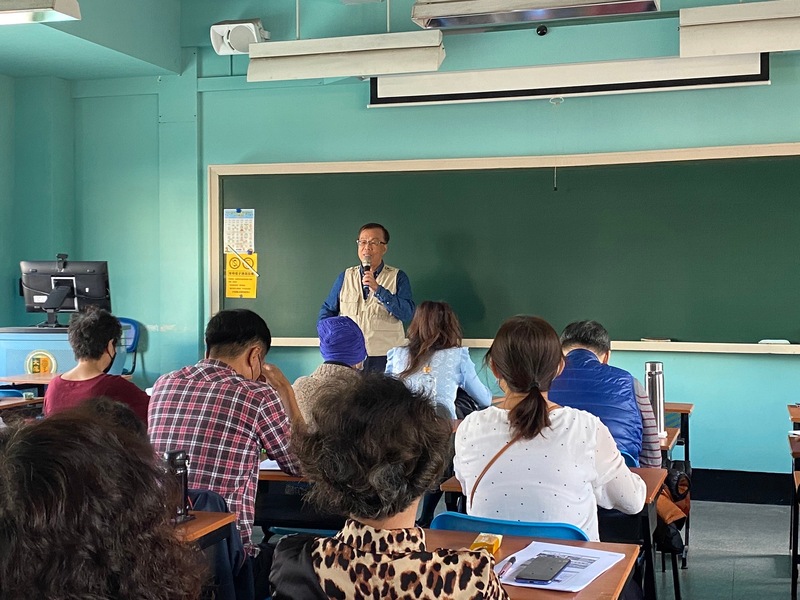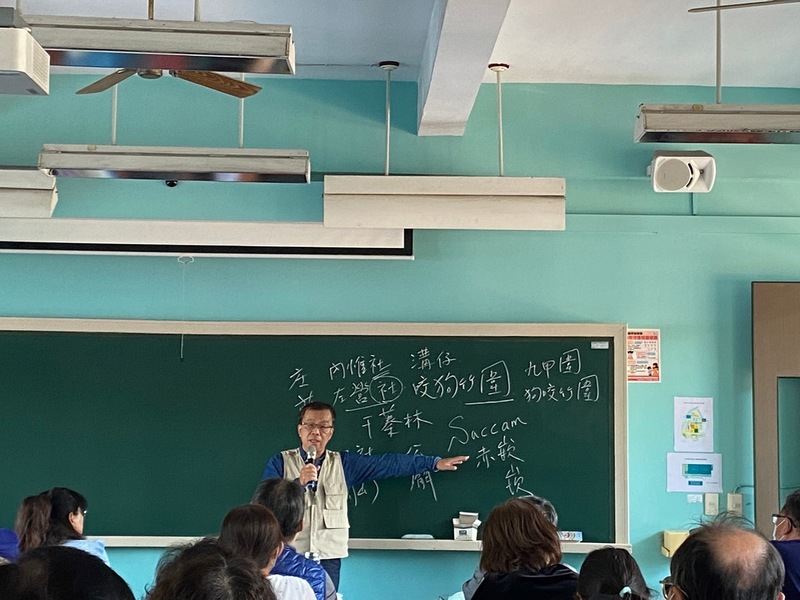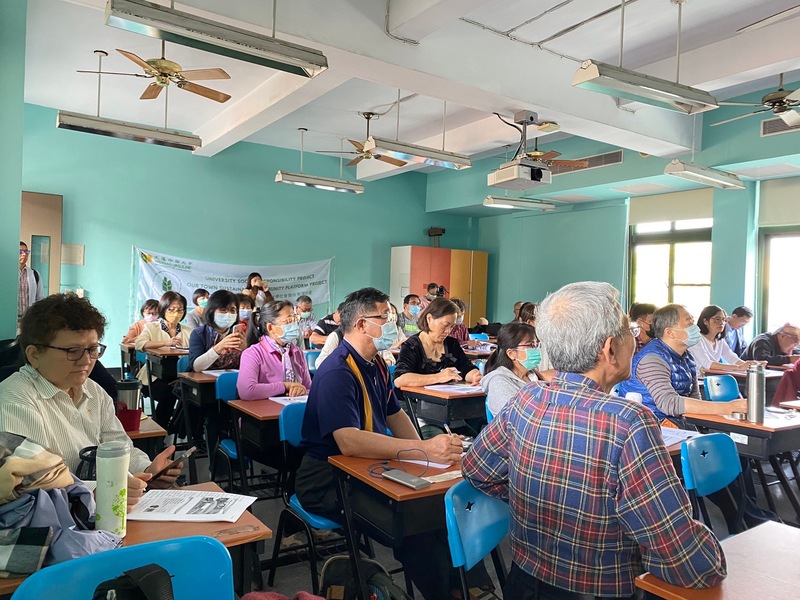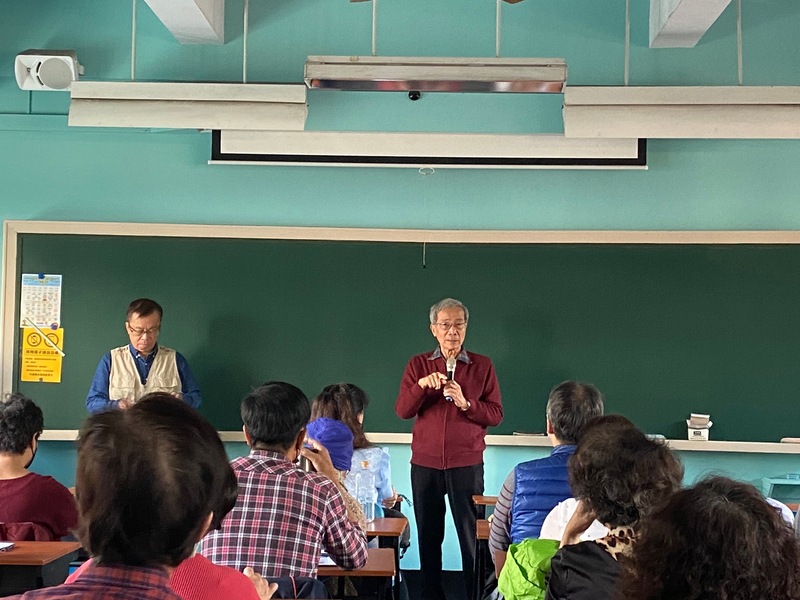by Rita, Project Student
Wenzao Ursuline University of Languages' University Social Responsibility Practice Program, "OUR TOWN Community Sustainable Cross-Domain Collaborative Platform Project" includes five community activities. Among these, the "Culture and History Innovative Community" organized its first lecture of the new year on February 17th. The community invited local cultural and historical researcher and chairman of Kaohsiung Cultural Association, Professor Guo Jiqing, to visit our school. Professor Guo explained the story of Kaohsiung's Cao Gong Irrigation Channel, covering its reasons for excavation, irrigated area, extended river section, and also the problems such as preservation and disposal needed to face.Through this lecture, participants followed Professor Guo's footsteps to travel back 180 years and explore the past and present of the Cao Gong Irrigation Channel.
Firstly, Professor Guo transformed himself into the visionary behind the Cao Gong Irrigation Channel - Cao Jin, the Fengshan Magistrate during the Qing Dynasty. From his perspective at that time, he eloquently narrated this rich historical story to the participants. "Cao Gong Irrigation Channel," a well-known waterway in Kaohsiung, is ubiquitous in daily life, yet few people understand the reasons behind its existence and its historical significance. In reality, the identity and status of the Cao Gong Irrigation Channel are not to be underestimated. During the Qing Daoguang era (in 1837 AD), Fengshan County, and the entire southern plain of Kaohsiung, faced severe drought. Faced with the unbearable living conditions of the farmers, Magistrate Cao Jin thought of the abundant water resources of Lower Tamsui River (now the Gaoping River). He envisioned using this location as a water source to construct a water channel for irrigating farmland. As a result, the two major systems, "Cao Gong Old Channel" and "Cao Gong New Channel," were established to address the water supply issues in south and north Kaohsiung. Subsequently, branches such as "Fengshan Channel," the "Daliao Channel" built during the Japanese colonial period, and the "Linyuan Channel" constructed after Taiwan’s Restoration, all played a crucial role in laying the foundation for water resources in Kaohsiung.
Additionally, Professor Guo briefly introduced the architectural features of some remnants of the Cao Gong Irrigation Channel. One notable structure is the water control gate of the old channel, known as the "Five-Hole Culvert" due to its five water inlet holes. At that time, Cao Jin used the five culverts, with brick-built arches, to regulate the inflow of water. Another noteworthy aspect is the boat-shaped steps at the bottom of the gate. Besides reducing the impact of water flow, these steps also served as a platform for personnel operations, such as handling items. Insights into such details reveal that a water channel project required consideration of various external environmental conditions to create a structure that aligns with the time and place.
Finally, it is inevitable to touch upon issues related to "preservation and abandonment." Professor Guo mentioned that any old building inevitably faces the dilemma of whether to be preserved or demolished. The significance of the Cao Gong Irrigation Channel has diminished in the present day, with many original water channels that once flowed through the urban areas of Kaohsiung now transformed into modern underground pipelines. Some have even become dirty drains where households dispose of waste indiscriminately. The original six-hole water control gate, due to concerns about nearby residents' property safety, was dismantled in 2006. All these phenomena reveal that the Cao Gong Irrigation Channel is gradually fading from public view. While there have been efforts to maintain and remediate the Cao Gong Irrigation Channel and Love River, the cultural preservation aspect requires collective efforts from the government, cultural and historical research experts, and the citizens. It should be recognized not just as a significant construction project but also as the cradle nurturing Kaohsiung's culture and economic development. Through this lecture, we hope participants will pay more attention to existing structures in their surroundings, contemplating their value and preservation methods, preventing them from silently disappearing into history.
The first lecture of the new year concluded successfully. Unlike previous sessions that focused on individual buildings, this time the theme centered around an irrigation system that influences the entire Kaohsiung plain area. Participants not only gained insights into cultural and historical aspects but also had the opportunity to contemplate various issues such as "water engineering design" and "balancing environmental and cultural preservation. "OUR TOWN Community Sustainable Cross-Domain Collaborative Platform Project," will continue to collaborate closely with the local community, plan engaging lecture topics, and actively seek scholars knowledgeable in local culture and history. By introducing more aspects of humanities and history, we aim to deepen the understanding of the participants about the place they grew up in. Together, we strive to contribute our efforts to the local community.

Opening remarks by Research Fellow Guo Jiqing

Introduction by Professor Guo Jiqing on the historical story of Cao Gongzun

Participants listen carefully to the lecture content and record key points in the handout

Expression of opinions by participating partners
